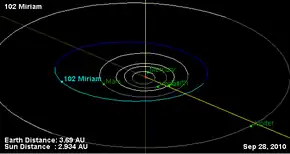 Orbital diagram | |
| Discovery[1] | |
|---|---|
| Discovered by | Christian Heinrich Friedrich Peters |
| Discovery site | Litchfield Observatory |
| Discovery date | 22 August 1868 |
| Designations | |
| (102) Miriam | |
| Pronunciation | /ˈmɪriəm/[2] |
Named after | Miriam |
| A868 QA, 1944 FC 1972 PC | |
| main belt[3] | |
| Orbital characteristics[3][4] | |
| Epoch 31 July 2016 (JD 2457600.5) | |
| Uncertainty parameter 0 | |
| Observation arc | 145.65 yr (53198 d) |
| Aphelion | 3.33419 AU (498.788 Gm) |
| Perihelion | 1.98782 AU (297.374 Gm) |
| 2.66101 AU (398.081 Gm) | |
| Eccentricity | 0.252981 |
| 4.34 yr (1585.5 d) | |
| 23.9115° | |
| 0° 13m 37.405s / day | |
| Inclination | 5.17832° |
| 210.856° | |
| 147.247° | |
| Earth MOID | 0.98566 AU (147.453 Gm) |
| Jupiter MOID | 2.13185 AU (318.920 Gm) |
| TJupiter | 3.333 |
| Physical characteristics | |
| Dimensions | 83.00±1.9 km[3][5] |
| 23.613 h (0.9839 d)[3] 15.789 hours[6] | |
| 0.0507±0.002[3][5] | |
| P (Tholen classification)[7] C (SMASSII classification)[7] | |
| 9.26[3][8] | |
Miriam (minor planet designation: 102 Miriam) is a moderately large, very dark main belt asteroid. It was discovered by C. H. F. Peters on August 22, 1868, from the Litchfield Observatory.[1]
Peters named the asteroid after Miriam, the sister of Moses in the Old Testament. This caused some controversy, because at the time, asteroids were expected to be named after mythological figures, and devout Christians and Jews would not regard Biblical figures as such. According to fellow astronomer Edward S. Holden, Peters deliberately chose a name from the Bible so as to annoy an overly pious theology professor of his acquaintance.[9]
Initially classified as a D-type asteroid, it was later classed as C-type based upon a broad absorption feature below 4,000 Å, most likely due to phyllosilicates on the surface.[10] An occultation of the star HIP 37136 by 102 Miriam on February 15, 2000 was observed from multiple stations, with the chords yielding an estimated elliptical cross-section of 96 × 62 km.[11]
Photometric observations of this asteroid during 2007 at the Organ Mesa Observatory in Las Cruces, New Mexico, were used to create a light curve plot. This showed a rotation period of 23.613 ± 0.001 hours and a brightness variation of 0.12 ± 0.02 magnitude. The curve shows three maxima and minima during each cycle.[12] This value for the period differs from the 15.789 hour estimate produced in a 2008 study.[6]
References
- 1 2 "Discovery Circumstances: Numbered Minor Planets (1)-(5000)". IAU: Minor Planet Center. Archived from the original on February 2, 2009. Retrieved December 31, 2008.
- ↑ "Miriam". Dictionary.com Unabridged (Online). n.d.
- 1 2 3 4 5 6 "102 Miriam". JPL Small-Body Database. NASA/Jet Propulsion Laboratory. Retrieved May 12, 2016.
- ↑ "(102) Miriam". AstDyS. Italy: University of Pisa. Retrieved December 31, 2008.
- 1 2 Tedesco; et al. (2004). "Supplemental IRAS Minor Planet Survey (SIMPS)". IRAS-A-FPA-3-RDR-IMPS-V6.0. Planetary Data System. Archived from the original on January 17, 2010. Retrieved December 31, 2008.
- 1 2 Johnson (2008). "Lightcurve Analysis of 102 Miriam, 1433 Geramtina, and 2648 Owa". The Minor Planet Bulletin. 35 (4): 151–152. Bibcode:2008MPBu...35..151J.
- 1 2 Neese (2005). "Asteroid Taxonomy". EAR-A-5-DDR-TAXONOMY-V5.0. Planetary Data System. Archived from the original on January 17, 2010. Retrieved December 27, 2008.
- ↑ Tholen (2007). "Asteroid Absolute Magnitudes". EAR-A-5-DDR-ASTERMAG-V11.0. Planetary Data System. Archived from the original on June 17, 2012. Retrieved December 31, 2008.
- ↑ Schmadel, Lutz D. (2003). Dictionary of Minor Planet Names. Springer Science & Business Media. p. 25. ISBN 978-3-540-00238-3.
- ↑ Fitzsimmons, A.; et al. (February 1994), "A spectroscopic survey of D-type asteroids", Astronomy and Astrophysics, 282 (2): 634–642, Bibcode:1994A&A...282..634F.
- ↑ Dunham, D. W.; et al. (September 2002), "Asteroidal occultation results multiply helped by Hipparcos", The Minor Planet Bulletin, vol. 73, no. 3, p. 662, Bibcode:2002MmSAI..73..662D.
- ↑ Pilcher, Frederick (June 2008), "Period Determination for 84 Klio, 98 Ianthe, 102 Miriam 112 Iphigenia, 131 Vala, and 650 Amalasuntha", The Minor Planet Bulletin, 35 (2): 71–72, arXiv:1203.4336, Bibcode:2008MPBu...35...71P, doi:10.1016/j.pss.2012.03.009, S2CID 119226456.
External links
- 102 Miriam at AstDyS-2, Asteroids—Dynamic Site
- 102 Miriam at the JPL Small-Body Database